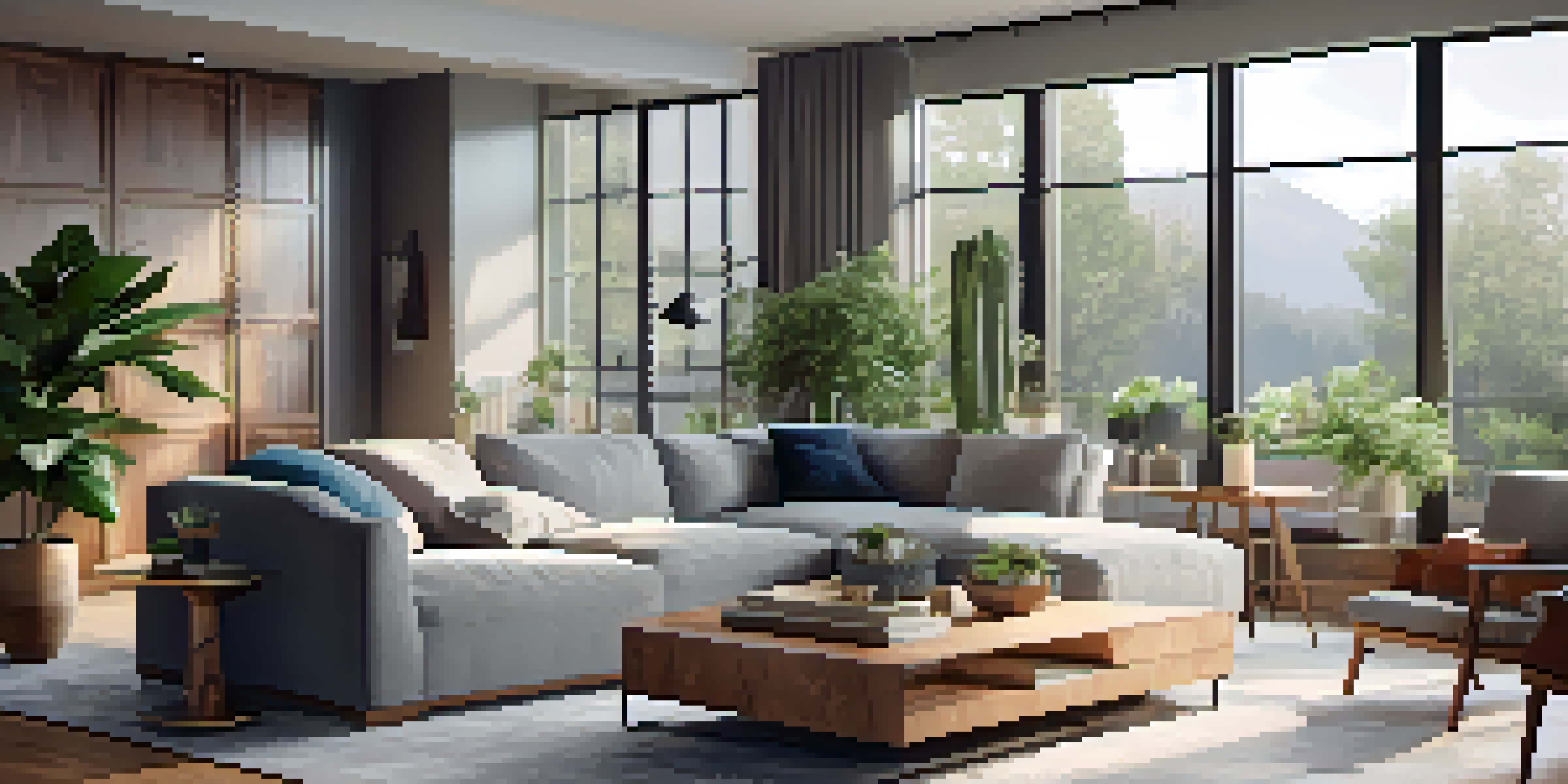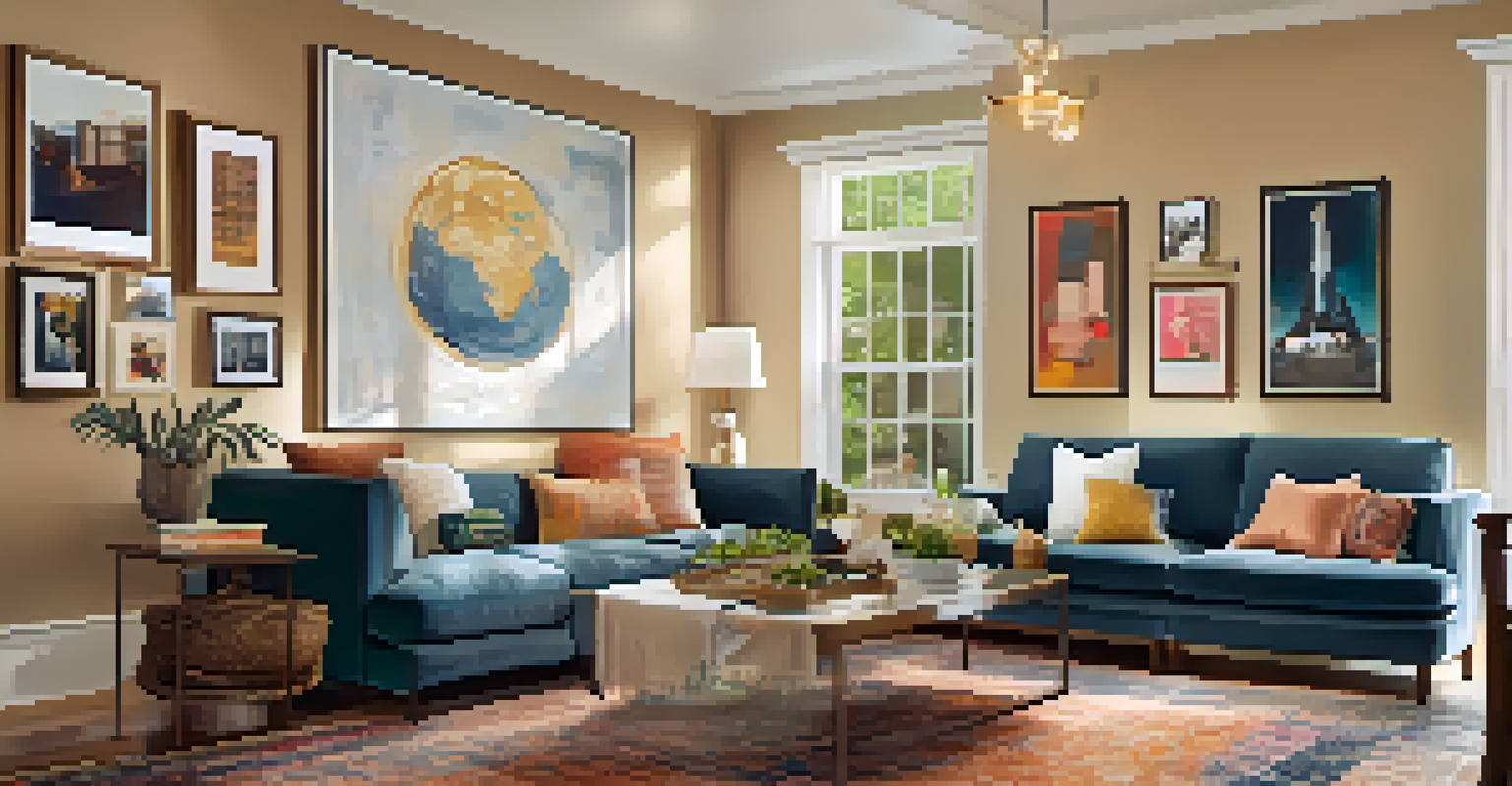The Role of Furniture in Open Concept Design

Understanding Open Concept Design and Its Appeal
Open concept design has gained popularity for its ability to create a sense of spaciousness and fluidity within a home. By removing barriers, it encourages interaction and a communal atmosphere, making it ideal for modern living. This layout is particularly appealing for families and those who enjoy entertaining, as it fosters connection between spaces.
Design is not just what it looks like and feels like. Design is how it works.
However, while the open concept is visually appealing, it requires careful planning to ensure that the space remains functional and inviting. Furniture plays a key role in this planning process, helping to define areas and provide comfort without compromising the open feel. A well-considered arrangement can transform an expansive area into cozy, usable zones.
Ultimately, the right furniture choices can enhance the open concept experience, making it more than just a trend. They can reflect personal style and accommodate various activities, from cooking to socializing, ensuring that the space serves multiple purposes effectively.
Choosing the Right Furniture for Defined Spaces
In an open concept design, choosing furniture that defines different areas is crucial. For instance, a large sectional sofa can create a living area while still allowing for easy flow to the dining space. Similarly, area rugs can delineate zones, adding warmth and character to the overall layout.

It's essential to consider scale when selecting furniture; oversized pieces can overwhelm a space, while too-small items may feel lost. Striking the right balance ensures that each area feels intentional and well-planned. For example, a robust dining table can anchor the dining area, while lighter, more airy furniture can keep the living space feeling open.
Open Concept Design Promotes Connection
By removing barriers, open concept design fosters interaction and a communal atmosphere, making it ideal for modern living.
Incorporating multifunctional furniture is also a smart strategy. Items like ottomans that double as storage or coffee tables that expand for dining purposes can save space and enhance functionality, making the most of every square foot.
Balancing Aesthetics and Functionality in Furniture Selection
When it comes to open concept design, achieving a balance between aesthetics and functionality is key. The right furniture should not only look beautiful but also serve a purpose tailored to the space's needs. For example, a stylish coffee table can serve as both a focal point and a practical surface for drinks and books.
The details are not the details. They make the design.
Consider the materials and colors of your furniture as they can significantly influence the overall vibe of the space. Lighter colors can make areas feel more expansive, while darker tones add depth and warmth. Mixing textures, such as a wooden table with plush chairs, can create visual interest without cluttering the space.
Ultimately, each piece of furniture should complement the others while contributing to a cohesive design. This harmony not only enhances the aesthetic appeal but also ensures that the environment remains comfortable and inviting for everyone.
Incorporating Vertical Space with Furniture Choices
While furniture typically sits on the floor, utilizing vertical space can significantly enhance open concept designs. Tall bookshelves or wall-mounted storage not only provide practical solutions but also draw the eye upward, making the area feel larger. This approach is particularly useful in spaces with high ceilings.
In addition to storage, vertical elements can showcase personal style. Artwork, plants, or decorative shelving can be used to express creativity and add character without overwhelming the horizontal space. For instance, a gallery wall can serve as a stunning focal point that connects various areas visually.
Furniture Defines Spaces Effectively
Choosing the right furniture and incorporating multifunctional pieces can help delineate areas while maintaining the open feel.
By thoughtfully incorporating vertical design elements, you can create a more dynamic environment that encourages exploration. This can make the open concept feel less like a series of disconnected areas and more like a cohesive home filled with personality.
Color Schemes: Uniting Spaces in Open Concept Design
A well-chosen color scheme can be a powerful tool in open concept design, helping to unify different areas and create a harmonious flow. Using a consistent palette throughout can visually link spaces, making transitions feel seamless. For example, soft neutrals can provide a calming backdrop, allowing furniture and decor to shine.
Accent colors can also be strategically placed to define specific zones. A bold hue in the dining area can set it apart while still coordinating with the living space. This technique not only enhances visual appeal but also helps in establishing distinct atmospheres for various activities.
Remember, the colors you choose should reflect your personality while complementing the function of each space. Whether you opt for vibrant tones or soothing pastels, your color scheme plays a vital role in crafting an inviting and cohesive open concept.
Lighting: Enhancing Functionality and Mood
Lighting is another crucial element that can significantly impact the overall feel of an open concept space. Combining natural light with layered artificial lighting can create a warm, inviting atmosphere. Strategically placed floor lamps, pendant lights, and wall sconces can enhance functionality in specific areas like reading nooks or dining tables.
Consider the moods you want to evoke in each area. Softer lighting can create a cozy ambiance in the living room, while brighter lights might be ideal for the kitchen and dining areas where tasks are performed. Dimmers can be a valuable addition, allowing you to adjust the brightness based on the occasion.
Personal Touches Create Unique Spaces
Adding personal items and meaningful decor transforms an open concept from generic to a true reflection of your personality.
Incorporating various lighting sources not only enhances the design but also adds depth and interest to the space. A well-lit open concept home is not only more enjoyable but also more functional, ensuring that every area can be used as intended.
Personal Touches: Making the Space Your Own
When it comes to open concept design, personal touches can truly transform a space from generic to uniquely yours. This can include anything from family photos and artwork to decorative pieces that reflect your interests and travels. These elements add warmth and character, making the space feel lived-in and loved.
Incorporating meaningful items can also spark conversations and connections among family and friends. For instance, a vintage globe on a coffee table or a collection of travel souvenirs on a shelf can tell a story and invite guests to share their experiences. This connection to personal history is what makes a house feel like a home.

Ultimately, your furniture and decor should reflect your personality and lifestyle. By thoughtfully curating pieces that resonate with you, your open concept space will be a true reflection of who you are, providing comfort and joy for years to come.